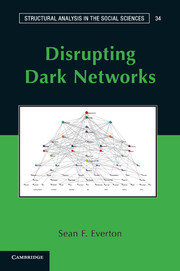Book contents
- Frontmatter
- Contents
- Figures
- Tables
- Preface
- Acknowledgments
- Part I Introduction
- Part II Social Network Analysis: Techniques
- Part III Social Network Analysis: Metrics
- Part IV Social Network Analysis: Advances
- 10 Dynamic Analyses of Dark Networks
- 11 Statistical Models for Dark Networks
- Part V Conclusion
- Appendix 1 The Noordin Top Terrorist Network
- Appendix 2 Glossary of Terms
- Appendix 3 Multidimensional Scaling with UCINET
- Appendix 4 The Just War Tradition
- References
- Index
10 - Dynamic Analyses of Dark Networks
Published online by Cambridge University Press: 05 April 2013
- Frontmatter
- Contents
- Figures
- Tables
- Preface
- Acknowledgments
- Part I Introduction
- Part II Social Network Analysis: Techniques
- Part III Social Network Analysis: Metrics
- Part IV Social Network Analysis: Advances
- 10 Dynamic Analyses of Dark Networks
- 11 Statistical Models for Dark Networks
- Part V Conclusion
- Appendix 1 The Noordin Top Terrorist Network
- Appendix 2 Glossary of Terms
- Appendix 3 Multidimensional Scaling with UCINET
- Appendix 4 The Just War Tradition
- References
- Index
Summary
Introduction
Networks are dynamic. They evolve and change over time as actors enter, leave, and move around. Capturing dynamics such as these and others can be difficult but it is possible. This chapter's purpose is to introduce readers to some of these approaches and demonstrate how to carry out relatively painless but potentially illuminating explorations of dynamic network data. We begin by examining approaches for exploring longitudinal networks both descriptively and statistically, although we do not consider in any great detail highly sophisticated approaches to the analysis of longitudinal network data, such as the actor-based models implemented by SIENA software (see, however, Murphy, Everton, and Cunningham 2012). A comprehensive exploration of these models deserves its own book and requires software other than UCINET, Pajek, or ORA. Next we turn to the fusion of social network and geospatial data, which allows analysts to not only geospatially plot social network data but also to calculate geospatially weighted metrics; both features complement existing social network techniques in helpful ways.
The Longitudinal Analysis of Dark Networks
Historically, longitudinal network data have been difficult to come by and the methods for examining them have been underdeveloped. In recent years, this situation has begun to change. Longitudinal network data and their analyses are becoming more common. Many of these have been largely descriptive in nature, but they are increasingly becoming more sophisticated, employing model-based approaches that seek to identify the underlying mechanisms of network change (Breiger, Carley, and Pattison 2003; de Nooy 2011; Doreian and Stockman 1997; McCulloh and Carley 2011; Snijders 2005; Snijders, Bunt, and Steglich 2010; Steglich, Snijders, and Pearson 2010).
- Type
- Chapter
- Information
- Disrupting Dark Networks , pp. 319 - 342Publisher: Cambridge University PressPrint publication year: 2012

